(Check out Part 1 here)
(Check out Part 2 here)
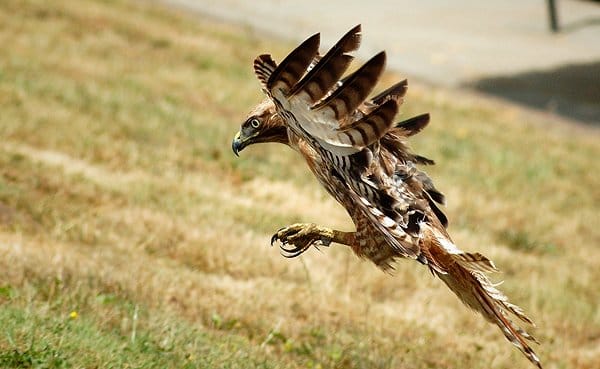
This hawk was a fierce hunter. I’ve seen young Red-tailed Hawks who just don’t have the hang of it, counting on luck of good fortune to present them with a careless gopher or a rare easy meal. Patch was focused and deliberate, consistent and inventive. She ate everything from Rock Pigeons to caterpillars, earthworms to Brewer’s Blackbirds, but her staple diet consisted of plump, toothy, charismatic, and abundant Pocket Gophers.
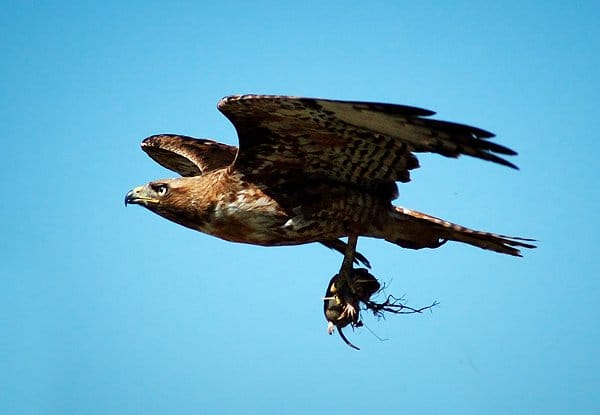
Her determination meant she often grabbed more than just the meal off the ground. Her technique entailed spotting the hapless gophers on the terraced hillside below and swopping down to grab them before they could retreat to the safety of their burrows. On more than one occasion I saw her reach down into a hole to grab her prey, or run across the ground to chase down a gopher that had left the safety of its underground network.
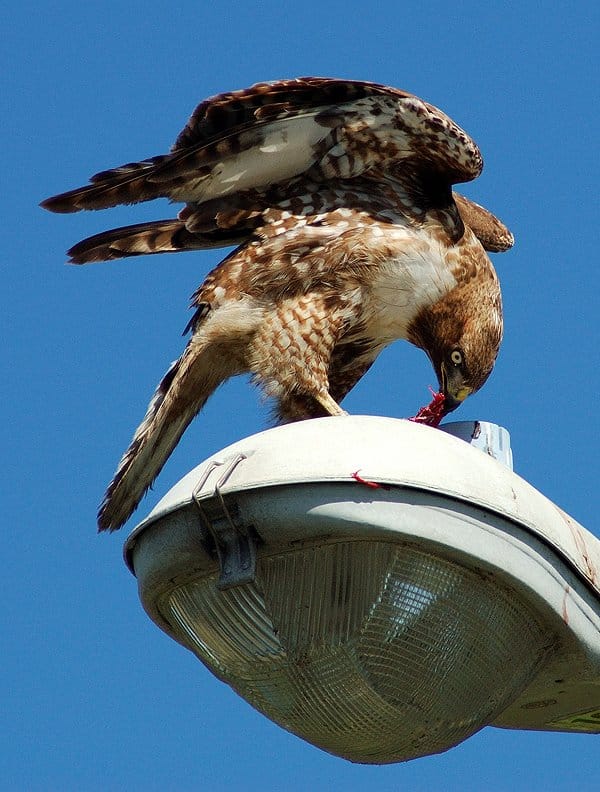
On this occasion Patch had secured a gopher and was dining on a streetlight. During the meal she was mobbed by several blackbirds and an American Robin. She shrugged them off and carried on with her meal. It seemed she was saving the head for last.
Just as she was getting around to finishing, another blackbird flew in and she ducked to evade the attack, dropping the severed gopher head which promptly stuck to the side of the streetlight just out of reach. She stared at the morsel for a minute of two, seemingly frustrated, and then snapped out of it, cleaned her bill and roused then flew off to preen in a tall Cypress tree.
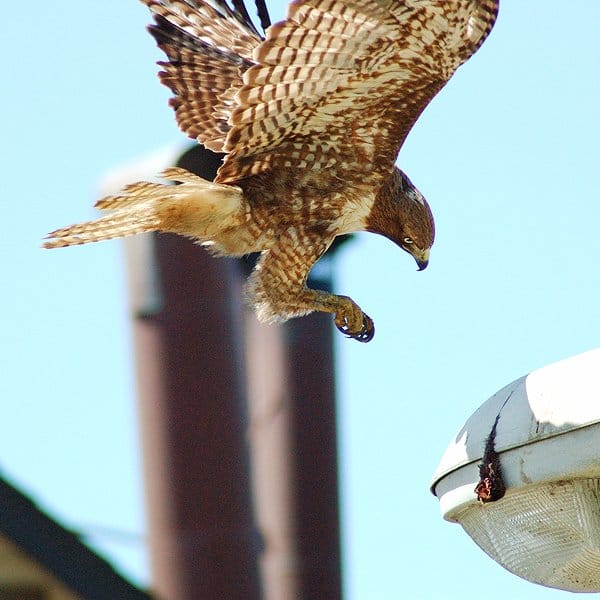
The next day I was following Patch around the park and she came to rest on the Alta Plaza Park sign. After 10 minutes of preening and stretching she turned and looked toward the streetlight where she had eaten the day before. Long stares were followed by her typical range-finding head bobs. Then to my surprise she leapt off the sign and flew toward the light, hovered momentarily…
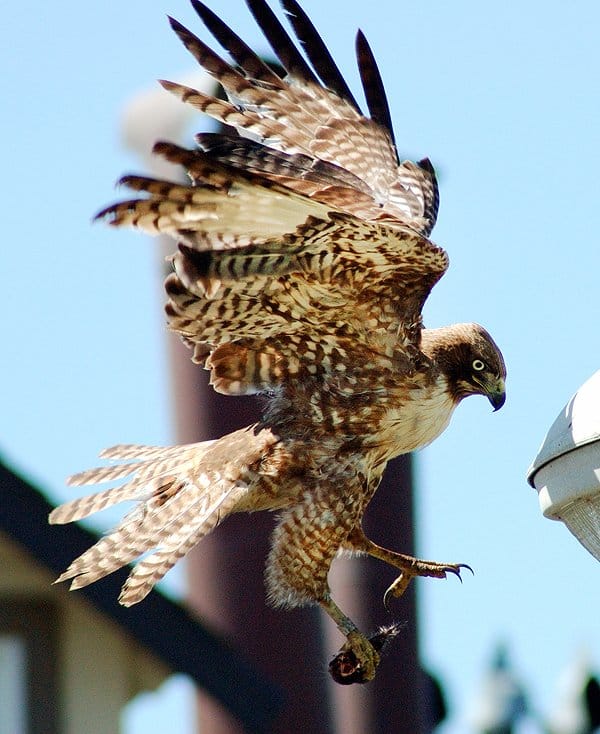
and snatched the gopher head right off the side of the fixture! She had remembered. She had inadvertently cached the food and come back for it in the midst of hunting for other things. It was a remarkable thing to see.
A few weeks later I watched Patch return to a favorite dining tree and pull half of a pigeon out from under a branch. As she picked at the keel I realized she must have caught it the day before… or possibly even earlier. Another example of cacheing but this time it was intentional.
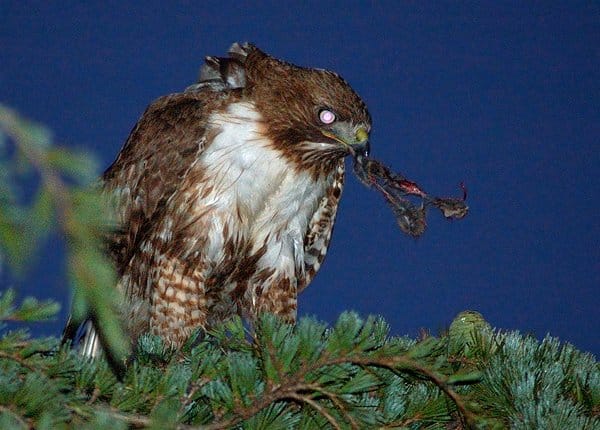
Another revelation came when I discovered she was hunting well into the night. It’s possible that streetlights extended the hours she could utilize her exceptional eyesight. Patch would float silently through the darkness and disappear onto the grassy hillside. She would usually find a place to roost after her late meals, calling it quits if she caught anything after sundown.
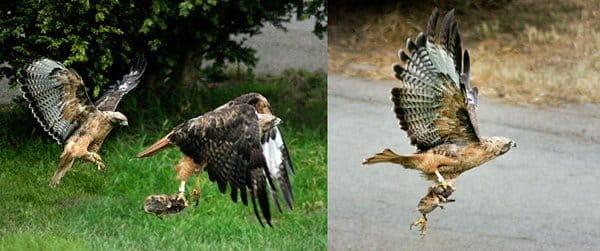
When she returned the following year she had refined her hunting technique. Having been gone for 5 or 6 months, she returned with a new style much less dependent on killing the prey on the ground. There may have been some danger inherent in spending too much time on the ground where she had wintered. Now Patch would reach down and pluck the gophers from the surface of the earth, carrying them wriggling and screeching up into the trees where she would dispatch them.
There will be more on Patch and her transition to adulthood in the next and final installment on December 16th. I’ll be in Tanzania when that post appears working on a new topic for January. Stay tuned.











Amazing photografs. Congratulations on the story that you have posted in such great detail. How will it end?
Congratulations on your powers of observation, your patience and your artistic skills! Great series!
Amazing that she came back after migration!! And, that she hunts at night…wow. Beautiful pictures…she is stunning! One of our urban RT in Washington Square, the Mom…Violet is not doing well…very sad, prayers needed for her please. http://www.palemale.com/no2620s1.html
Walter your writing skills are only surpassed by your photography skills. Love reading and looking at your posts.
Thank you all for the generous responses. This really was a special relationship/interaction with a wild bird and I’m glad I have the pictures as a visual diary of the encounter. Even happier to be able to share them with you.
What an exceptional and poignant story. I’m just amazed by the proximity and intimacy Patch afforded you through her escapades. Beautiful work.
@JoyAnn, I linked out to the story about Violet, but didn’t see a comment area. Is there a wildlife rescue in the area? In SF, Wild Rescue was recently able to capture an RT who’d been injured by a nail gun but was still flying and hunting.
Thanks for asking Ingrid…Yes they have been working on it…as you can see from Walt’s beautiful photos, they hunt with great skill very quick also there is plenty of prey in the park and her mate hunts for her also, not easy to catch, so sad. So thanks Walter for your majestic pics and wonderful story! can’t wait for part 4 !
Walter, your photos are extraordinary. I too blog photos of red-tailed hawks. I happen to run a blog following the NYC red-tailed hawks mentioned in a couple of the above comments. The site is http://rogerpaw.blogspot.com/.
I’ve seen your series before and was happy, in a bittersweet way, to now see mention of our local injured hawk. I write ‘happy’ only because it’s good to know that lots of folks are getting the word out on her condition and efforts to help her. I’ll be providing updates on Violet’s condition as soon as I learn more.
Thanks for your gorgeous work!
I’m sure you’ve been asked a hundred times but would you mind sharing what camera and lens(es) you use for these photos? I use a Canon EOS 7D with a Canon EF 100-400mm f/4.5-5.6 L IS USM lens for all my hawk shots these days.
All the best,
“Roger_Paw”
“Roger_Paw,”
Thanks for your response. I’ve been a fan of your photographs for a while. Next time I’m in NYC I’d love to tag along or talk about good places to go shoot.
Most of these images were taken with a Nikon D50 and a 70-300 lens. Later I upgraded to a D90 but that was after my time with Patch. Lately I’ve been shooting with a D3x and a 70-200 2.8 with a doubler, that I had to get for the resolution needed for a mural project at San Francisco International Airport http://birdlightwind.com/2011/11/13/sf-bird-encounters-the-mural/
It is a beast of a camera but now that I’ve had it for a while I love it. It is overkill but it works well.
But most of the images were taken with a D50 which I think was an 8 megapixel entry level DSLR.
Walter, thank you so much for your kind response. I am so flattered! It’s nice to know there is this small but devoted band of hawk bloggers/photographers out there and to be a part of it.
Thanks for sharing what kit you use and for sharing the link to your photo mural. It is astonishing and beautiful! No camera and lens kit is overkill in my opinion. 🙂 I am actually new to photography so don’t know much about the craft but I’ve definitely been bitten by the bug.
Kind regards,
RP